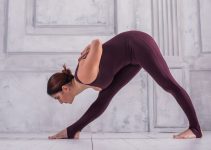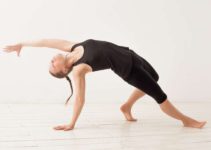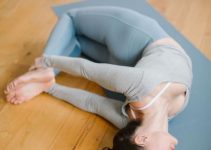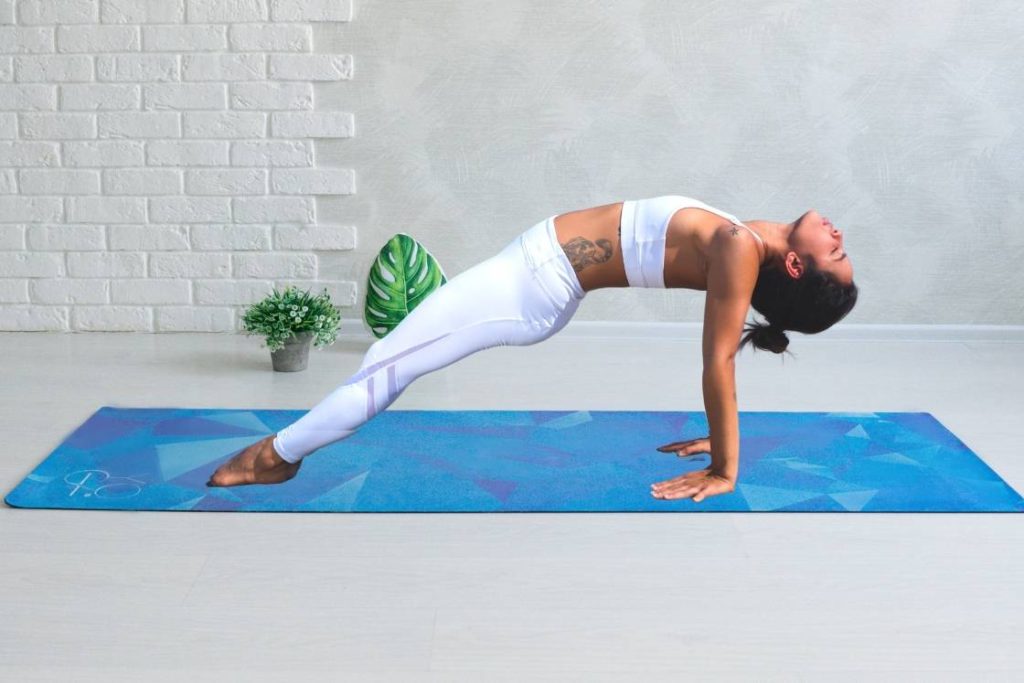
Purvottanasana or eastward facing stretch or upward plank pose strengthens the back, wrist, and leg muscles. It is a full-body workout stimulating the anterior and posterior muscles of the body.
Based on the difficulty level, it’s an intermediate posture as it requires strength, stretch, and balance in the body. Besides this, it also includes inversion of the head and neck.
To come into this pose, begin by sitting in dandasana (staff pose). From there the arms are drawn back planting the hands on the floor. It is followed by lifting the hips and legs with feet on the ground. The entire body is balanced on the hands and feet with the head hanging backward.
This posture is beneficial to open the hips, shoulders, and chest muscles. It is a counter pose for all the forward bends and relieves the accumulated tensions in the muscles.
Purvottanasana Meaning
Like most of the yogic poses, Purvottanasana has got its name from the yogic language Sanskrit. It consists of three root terms:
- “Purva” means “east” or “front of the body”.
- “Uttana” refers to “intense stretch”
- “Asana is “pose”
In this posture, the front of the body, extending from head-to-toe is intensely stretched, hence the name.
In English, it is referred to as eastward facing stretch. Holding this pose the body resembles the plank pose although in an inverted position. Therefore, it is also known by the names of an inverted plank, upward plank, or reverse plank pose.
Some practitioners also refer to it as an inclined plane pose, due to the posture that the body attains while performing purvottanasana.
Symbolic representation
Purvottanasana also signifies the refreshing and revitalizing of the body. As the east is the direction of sunrise, it’s a symbol of new beginnings and potential.
Therefore, practicing purvottanasana is assumed to energize the entire body every time the practitioner attains the pose.
Practice Guide of Purvottanasana

Contraindications
- Do not perform purvottanasana if you have an injury at the wrist, neck, or back.
- People with high blood pressure should never perform it without the expert’s supervision.
- Avoid this pose if have a severe migraine.
- People having carpel tunnel syndrome must not perform this pose.
- Patients of cervical spondylitis must refrain from this asana.
Preparatory Poses
The following poses below will remove stiffness of the back, warm up legs, energize the entire body to come, and hold purvottanasana easily.
- Cow Face Pose (Gomukhasana)
- Reclining Hero Pose (Supta Virasana)
- Bridge Pose (Setu Bandha Sarvangasana)
- Bow Pose (Dhanurasana)
How to Do Purvottanasana (Steps)
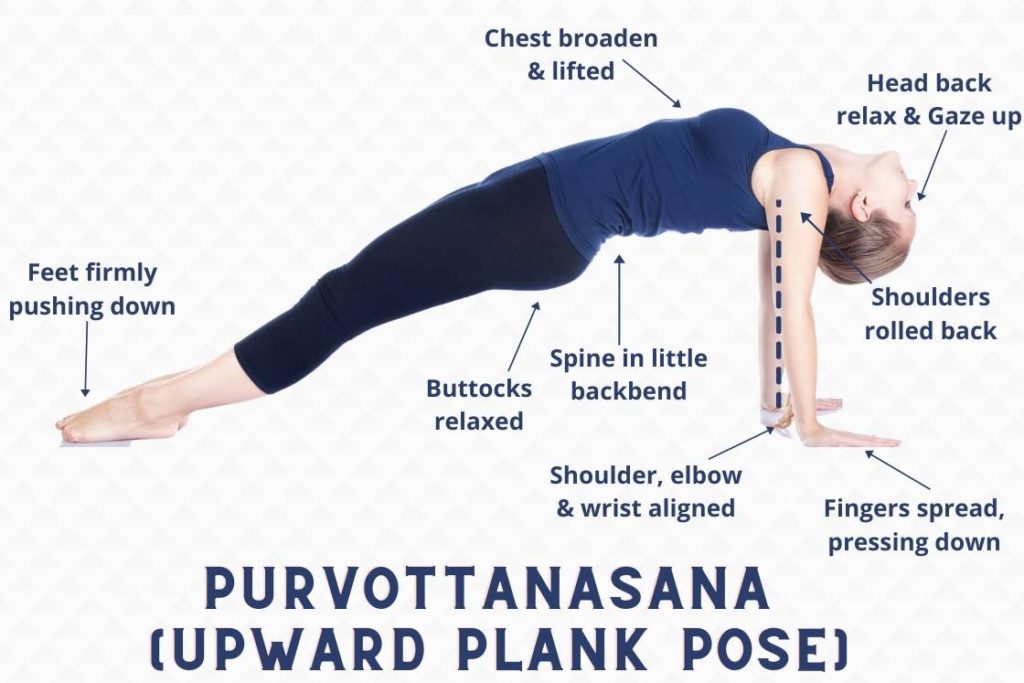
- Begin by sitting in dandasana.
- Drawing your arms backward place your hands behind the hips. Keep the fingers pointing towards the feet.
- Bend your knees with feet placed a foot away from buttocks.
- Exhale and pressing your hands and feet to the floor lift your hips to attain an inverted tabletop position.
- Maintaining the hip position straighten your legs forward, one at a time.
- Keep the toes and feet firm on the floor raising the hips up to shoulder level.
- Gently drop the head backward fixing the gaze on the ceiling.
- Hold the pose for 30 seconds and keep breathing.
- Inhale bring the chin back to the chest.
- Exhale drop the hips to the floor and release the hands.
- Relax the body in dandasana.
Precautions
- Do not drop the neck if you have a headache or strain on the neck. Instead, perform the pose keeping the chin to the chest.
- Keep the wrists under the shoulders.
- Open your chest fully by rolling the shoulders onto the back.
Follow-up poses
Props and Modifications
Using the following props below, one can modify Purvottanasana in its easier variation.
- Blocks – Place two blocks behind your hips as you sit in dandasana. Bring your hands back and place your hands on the blocks. Lift the hips and legs off the floor placing hands on the blocks.
- Another block modification – Stack 3-4 blocks on the floor. Sit on the top of these stacked blocks with legs extended forward. Slowly lean back placing the hands on the floor with straight arms. Perform purvottanasana over them maintaining the integrity of the hips to hold the pose longer.
- Chair – Place a chair behind you performing the dandasana. Reach its seats with the hands. Lift the body up pressing the hands on the edge of the chair.
- Chair with bolster – Place a bolster over a chair behind you. Take your hands behind your hips and perform purvottanasana. While dropping the head backward you can rest your head over the bolster.
Variations
One can choose from a variety of options to deepen or ease the Purvottanasana;
1. Kona purvottanasna
This is an advanced variation of purvottanasana where the body is held on forearms instead of palms.
Sit in dandasana and draw the arms to the back. Place your forearms and hand on the floor. Engaging the core muscles to lift the legs, hips, and torso off the floor.
1. salamba purvottanasna
salamba means supported. It’s a restorative variation of purvottanasana taught in Iyengar yoga. In this variation, a chair having seat covered with blankets and a folded mat is used to support the back.
2. Purvottanasana legs at the right angle
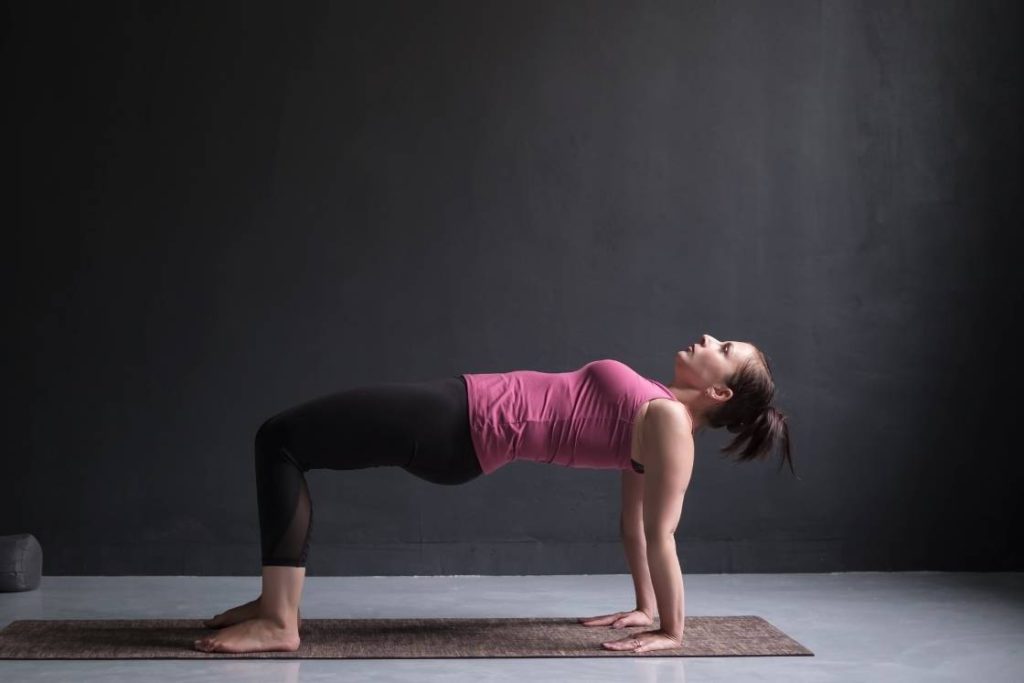
This is also called reverse tabletop pose. Come in full upward plank pose. Then slowly slide your feet back while lifting your back. Slide feet up to the point where feet come directly under the knees thus body comes in a tabletop position.
3. Purvottanasana hand variation
Beginners find this variation helpful as it feels more comfortable over the shoulders. Sit in dandasana placing the hands behind the hips with fingers pointing outwards and thumb towards the feet. Then follow the further steps as mentioned in the above instructions.
4. Purvottanasana one foot on opposite knee
Perform purvottanasana with hands behind you and fingers pointing away. Shift the body weight towards the right side. Gently lift the left foot and place it over the right knee. Hold the pose maintaining balance on hands and one leg.
5. Purvottansana one leg raised
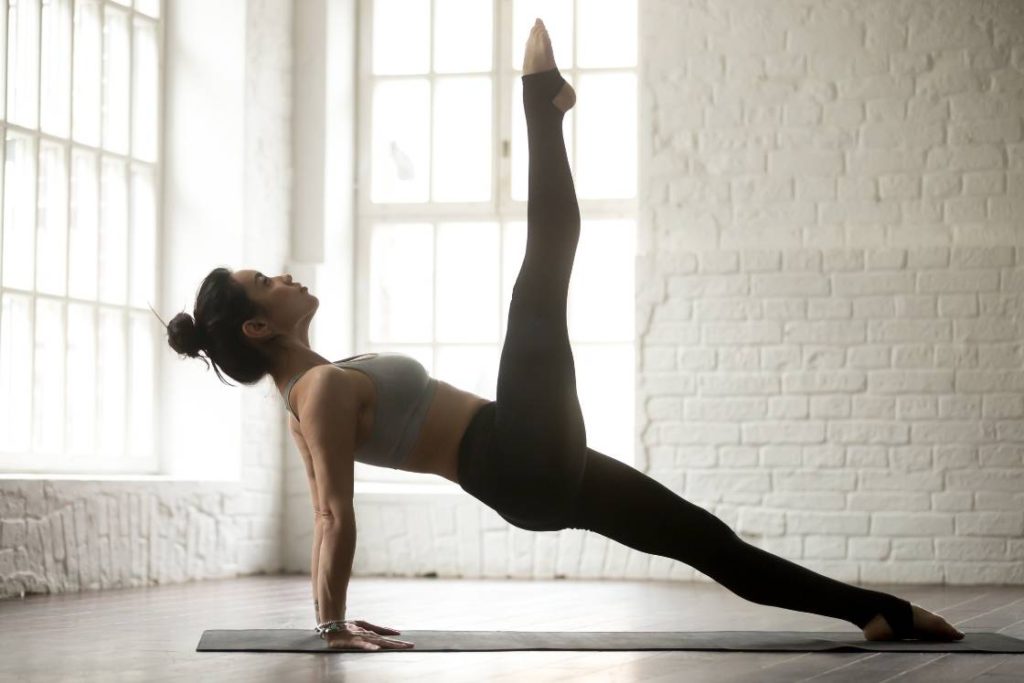
Perform purvottanasana, slowly lift one foot off the ground. Extend the lifted leg upward with toes pointing forward. Then, raise the leg perpendicular to the floor with toes pointing to the ceiling.
Therapeutic Applications
Purvottanasana strengthens the wrists and ankles, improves the movement
of the shoulder joints and expands the chest fully.
~ Light on Yoga, B.K.S Iyengar
- Purvottanasana is a great practice to improve the shoulders’ alignment. People with rounded or drooping shoulders must perform this pose.
- It stretches the hip muscles along with the spine. Also, dropping the head backward enhances fresh blood supply to the brain. This calms the brain and relieves fatigue, stress, and depression.
- This pose also eases the heaviness and discomfort felt in the abdomen during menstruation.
Purvottanasana Benefits
1. Strengthens the arms and legs
While holding purvottanasana, the entire body is balanced on the hands and legs. The arms are kept straight with extreme pressure on the wrists. The inner thighs, glutes, and calf muscles are stretched throughout the pose.
It expands these muscles and enhances endurance, thereby making the arms and legs stronger.
2. Opens the chest
The shoulders muscles are also stretched to keep the hands on the floor balancing the body. It expands the chest and dropping the head backward uplifts the heart. It improves the heart rate and circulatory system.
3. Stimulates respiratory organs
The opening of the chest expands the internal organs including the lungs. The expansion of the lungs enhances the supply of oxygen. This eventually improves breathing capacity and hence stimulates the respiratory system.
4. Improves spine flexibility
The back and hips are lifted off the floor. The entire back is stretched immensely by pulling the spine towards the neck as well as pushing the feet away from the body.
These counter forces help in elongating the entire spine improving its flexibility.
5. Maintains metabolism
In purvottanasana, the thyroid gland is activated. It helps in optimum secretion of thyroid hormones, that regulate the metabolism of the body.
6. Provides a toned body
Purvottanasana is an intense stretch for the entire body. It stretches all the muscles extending from toes to the neck. Balancing the body on hands and feet requires enough strength and burns calories.
It helps in getting rid of fat accumulated around the thighs, hips, abdomen, and chest region.
7. Activates the Anahata chakra
The expansion of the chest muscles in the pose provides energetic benefits. It stimulates the heart chakra (Anahata). It benefits the heart, lungs, along with improving the immune system by stimulating the thymus.
Also, brings positive feelings like happiness, love, and compassion to the practitioner.
